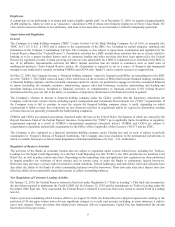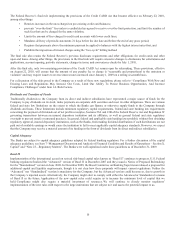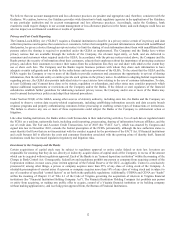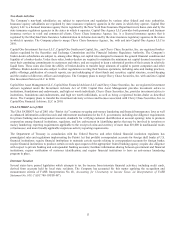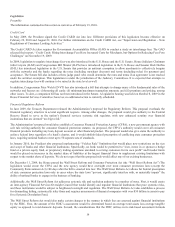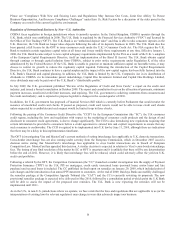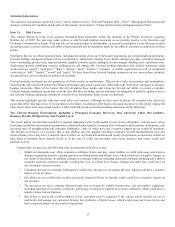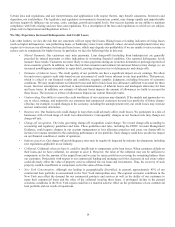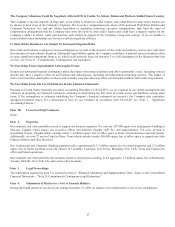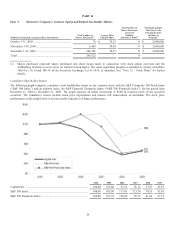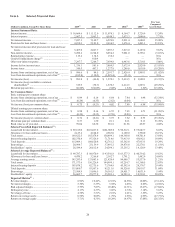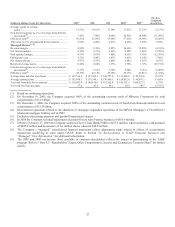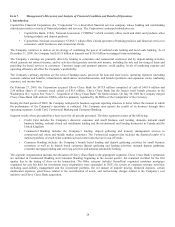Capital One 2009 Annual Report Download - page 31
Download and view the complete annual report
Please find page 31 of the 2009 Capital One annual report below. You can navigate through the pages in the report by either clicking on the pages listed below, or by using the keyword search tool below to find specific information within the annual report. 18
• Our ability to borrow from other financial institutions or to engage in funding transactions on favorable terms or at all
could be adversely affected by further disruptions in the capital markets or other events, including actions by rating
agencies and deteriorating investor expectations, which could limit our access to funding. As a result of these market
conditions, we have increased our reliance on deposit funding. This shift results in higher levels of owned loan receivables
and related increases in our allowance for loan and lease losses.
• Increased charge-offs, rising LIBOR and other events may cause our securitization transactions to amortize earlier than
scheduled, which could accelerate our need for additional funding.
• An inability to accept or maintain deposits or to obtain other sources of funding could materially affect our liquidity
position and our ability to fund our business. Many other financial institutions are increasing their reliance on deposit
funding and, as such, we expect increased competition in the deposit markets. We cannot predict how this increased
competition will affect our costs. If we are required to offer higher interest rates to attract or maintain deposits, our
funding costs will be adversely impacted. In addition, our ability to maintain existing or obtain additional deposits may be
impacted by factors beyond our control, including perceptions about our financial strength, which could lead to consumers
choosing not to make deposits with us.
• Regulators, rating agencies or investors could change their standards regarding appropriate capital levels for banks in
general or our company in particular. If we are unable to meet any such new standards, it could have negative impacts on
our ability to lend, to grow deposits, and on our business results.
• Increased prepayments, refinancings or other factors could lead to a reduction in the value of our mortgage servicing
rights, which could have a negative impact on our financial results.
Compliance With New And Existing Laws And Regulations May Increase Our Costs, Reduce Our Revenue, Limit Our Ability
To Pursue Business Opportunities, And Increase Compliance Challenges
There has been increased legislation and regulation with respect to the financial services industry in the last few years, and we expect
that oversight of our business will continue to expand in scope and complexity. A wide array of banking, consumer lending, and
deposit laws apply to almost every aspect of our business. Failure to comply with these laws and regulations could result in financial,
structural and operational penalties, including receivership. In addition, establishing systems and processes to achieve compliance with
these laws and regulations may increase our costs and/or limit our ability to pursue certain business opportunities.
On January 12, 2010, the Federal Reserve Board released a final rule under Regulation Z (“Truth in Lending”) which incorporates the
provisions required to implement the Credit Card Act and the Federal Reserve’s amendments to Truth in Lending under its December
2008 final rule. These provisions impact credit card’s primarily, but will also impact other open-end loans. The Credit CARD Act will
prohibit or limit a number of industry practices such as repricing starting February 22, 2010. The provisions in the final rule also will
require extensive changes to disclosures for solicitations and applications, account opening, periodic statements, changes in terms, and
convenience checks by July 1, 2010. Although the Company has not engaged in many of the practices prohibited by the amendments,
the rules could have a material adverse effect on future revenues in our U.S. credit card business and could make the card business
generally less resilient in future economic downturns. In particular, the rules will prohibit an increase in the interest rates applied to
existing credit card balances except in limited circumstances. Forthcoming regulations addressing unrepricing requirements and
reasonableness of penalty fees for credit cards also may have further impacts to revenues and costs. Unrepricing requirements could
require issuers to reverse all or part of any APR price increases instituted since January 1, 2009. Rules regarding “reasonable and
proportional” penalty fees could limit the amount of such fees. Likewise, several bills pending before Congress could impact credit
card pricing and other terms.
In June 2009, the Treasury Department released a proposal to reform the financial services industry. This proposal gives the Federal
Reserve Board authority to serve as the nation’s financial services systemic risk regulator, with enhanced scrutiny over financial
institutions that are deemed “too big to fail.” The proposal could also establish a Consumer Financial Protection Agency (the
“CFPA”), a new government agency with sole rule writing authority for consumer financial protection statutes. As proposed, the
CFPA’s authority would cover all consumer financial products including any loan, deposit account or other financial product.
In addition, legislation has been introduced that could enable merchants to negotiate interchange fees, which are the discounts on the
payment due from the card-issuing bank to the merchant bank through the interchange network. If enacted, any subsequent
negotiations with merchants could reduce the interchange fees that the Company is able to collect. The future of these bills is
uncertain, but each, or additional legislation, could be introduced or reintroduced in 2010. We face similar risks with respect to our
international businesses, where changing laws and regulations may have an adverse impact on our results.
Finally, broad bankruptcy legislation that could create incentives for consumers to choose Chapter 13 bankruptcy as a primary remedy
for mortgage related problems was introduced in Congress in 2009. Such legislation, if enacted, could result in an increase in
bankruptcy filings, which could lead to increased credit losses in certain of our lending businesses, such as credit cards and Auto
Finance, and could have an overall negative impact on our results of operation.



